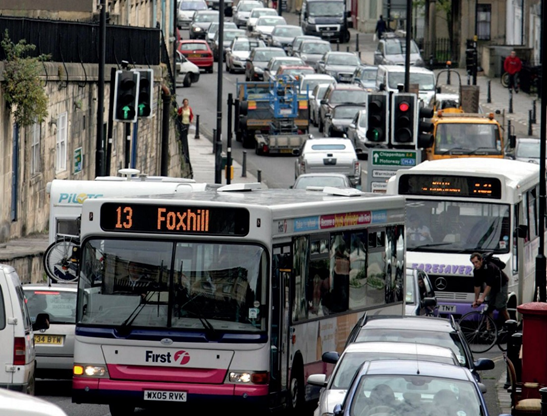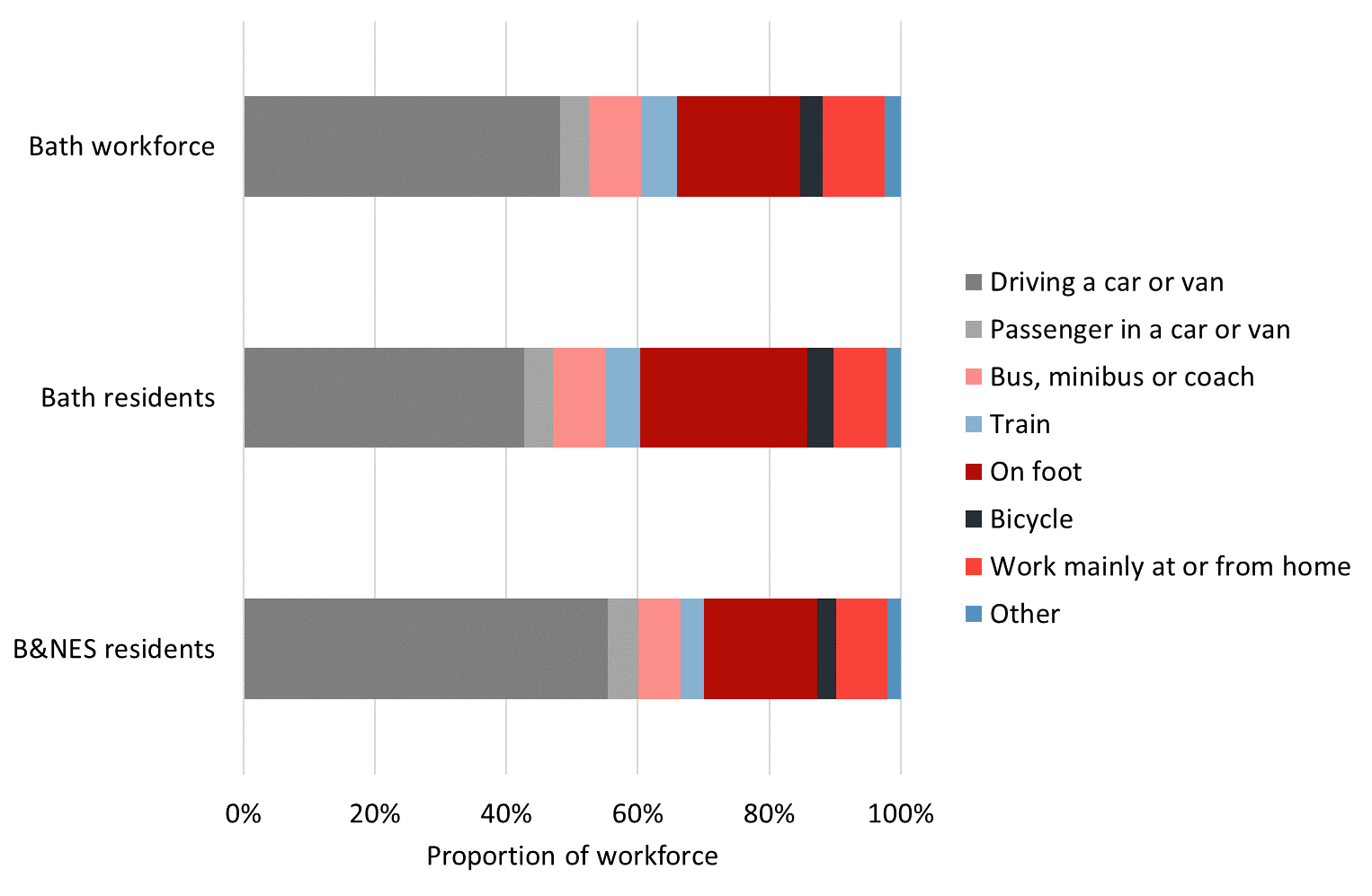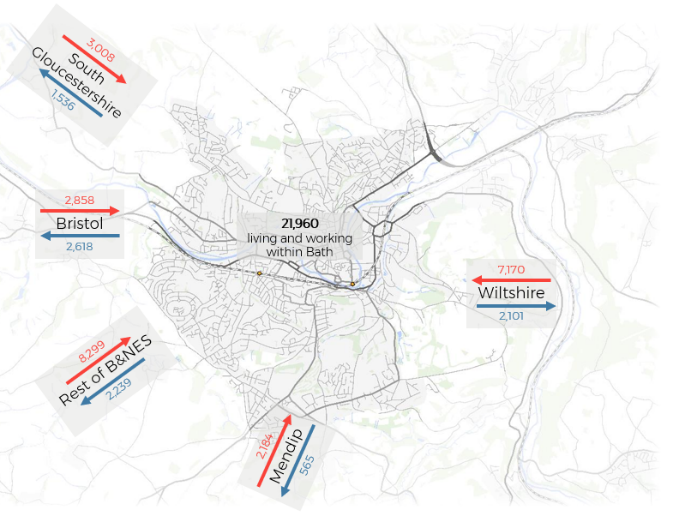- Chartered Institute of Highways and Transportation
Contents of the plan
Journey to Net Zero: Reducing the environmental impact of transport in Bath sets out a plan to tackle some of the biggest challenges our society faces:
- Combatting climate change
- Improving air quality
- Improving health and wellbeing
- Tackling congestion
The current ways in which we travel will not get us to carbon neutrality by 2030. This plan sets out the changes needed to our transport system to create places we want to live and work, with better-connected, healthier, and genuinely sustainable communities. We have placed people at the centre of Journey to Net Zero, focusing on providing transport infrastructure and environments that will encourage the use of sustainable modes of transport, by making them a genuine alternative to the car.
This will involve reducing the dominance of the private car, while maintaining access for those whose needs cannot easily be met by more sustainable modes of transport. This plan focuses primarily on the City of Bath, but also recognises the importance of the travel corridors between the city and the wider district.
This journey has already begun. We are pursuing an ambitious, wide-ranging programme of projects to support travel within Bath, the wider district and the region. This plan sets out the steps that we have already taken, and those that we are currently working on. But these alone are not enough to deliver carbon neutrality. The targets in the Climate Emergency Outline Plan demonstrate the scale of change required, so we have identified future projects that will support us on our journey to carbon neutrality.
In this plan, we have considered – at a high level – the potential scale of carbon reduction that future projects could deliver. As the projects identified in this plan develop, we will consider their impact on reducing carbon in more detail, and estimate quantified impacts. We will continue to work with the West of England Combined Authority (the Combined Authority) to develop more advanced techniques for recording and monitoring the impacts of our transport projects, to allow us to measure performance against emission targets.
In 2020, the Combined Authority released the Joint Local Transport Plan 4 (JLTP4) to set the vision for transport in the region to 2036. JLTP4 recognises the challenges faced by the region, in terms of growth in travel demand and the increased need to improve the offer of more sustainable modes of transport, as well as climate challenges. JLTP4 remains the umbrella document for regional policy, and is the source of the region’s major scheme list (or set of projects due to be implemented). Where appropriate, schemes identified in JLTP4 have been included within this plan.
An evidence-based approach
In November 2014, we approved the Getting Around Bath Transport Strategy. This Strategy set out our vision and objectives for transport in the region. To reflect the importance of the Climate Emergency declaration on our future ambitions, we have updated our vision and objectives:
Vision
Bath will enhance its unique status by adopting measures that promote sustainable transport and decision making, whilst reducing CO2 emissions and the intrusion of motor vehicles, particularly in the historic core. This will improve the quality of life for local people and enable more economic activity and growth, while enhancing the special character and environment of the city.
Objectives
- Reducing vehicle carbon emissions to achieve carbon neutrality by 2030
- Improving air quality and health
- Promoting sustainable mobility
- Supporting and enabling economic growth, competitiveness, and jobs
- Widening travel choice
- Widening access to opportunities for jobs, learning, and training
- Supporting travellers to make sustainable travel choices
- Safeguarding and enhancing Bath's unique historic environment and World Heritage Site status
- Improving quality of life in the city
Journey to Net Zero: Reducing the environmental impact of transport in Bath builds on the 2014 Transport Strategy, to support targets to reach carbon neutrality by 2030. In April 2020, we published the Journey to Net Zero Phase 1: Current and Future Report. This sets out the current and future situation for transport into, out of, and around Bath, as well as the need for significant and focused improvements. This report looks at the ways in which we currently travel, and provides the evidence base that underpins the consideration of future transport measures set out in this plan.
This document forms the second part of our Journey to Net Zero report, identifying measures to overcome the challenges identified in the Current and Future Report. When combined, these reports identify problems that currently affect travel in the district, and explore solutions to improve and promote sustainable travel in, around and into the city.
How the plan is organised
The plan considers projects in three groupings, based on their level of development:
- Current projects
These are projects that are already underway, that we are developing, or have delivered. These projects have been consulted on, and assuming the resource and funding is available, they will be delivered (if they have not already been) - Projects in development
These are projects which are under development, and are subject to consultation and approval before they can progress - Future projects
These are emerging projects that are not currently under development, but we could pursue, in order to support the ambition to achieve carbon neutrality by 2030
These projects include those that we are developing and consulting on together with the Combined Authority. We will consult on projects in development and future projects in detail in the future, ensuring that local people are able to give their views on the proposals.
Within the plan, projects are considered in terms of their delivery timescale:
- Short-term: 1 to 2 years
- Medium-term: 3 to 6 years
- Long-term: 7 to 10 years, or more
Context of the plan
In 1987, the City of Bath was celebrated on the United Nations’ Educational, Scientific and Cultural Organisation (UNESCO) list of World Heritage Sites, in recognition of its ‘outstanding universal values’. But over the past century, the increasing dominance of the motor car has damaged its character, and the quality of public space, and of life, across the city.
The ancient road network within Bath city centre was not designed to cater for the competing demands of cars, buses, coaches, and heavy goods vehicles. Dense traffic generates high levels of dangerous air pollution, whilst causing costly delays to journeys, and making it harder to get around on foot and by bike.
The declaration of the Climate Emergency provides an unparalleled opportunity to look at Bath as a whole, and to develop a coherent, long-term vision and plan for transport in the city.
No single mode of transport will be dominant. Instead, people will have a choice between a range of modes of transport, each of them accessible, viable and sustainable.
Understanding travel in Bath
To plan for the change required, we first need to understand the characteristics of travel in Bath. During the development of the plan, the coronavirus pandemic has had a significant societal impact on the way we travel, live and work. The experience of the pandemic shows that in certain conditions, people’s travel behaviour can change rapidly. The long-term impacts of the pandemic on travel are unknown, so the data and analysis presented and discussed within this chapter is pre-pandemic. Monitoring data that we have collected recently shows that traffic levels are nearing 90% of pre-pandemic levels, suggesting that the need for sustainable transport remains.
Expand the sections below to find out more about why, how, and where we travel.
On average, each person in England makes 953 trips per year, with an average trip length of 10.9 kilometres and an average journey time of 23 minutes. With a population of 193,000 in B&NES, this equates to over 2 billion kilometres travelled per year in the district.
Almost half of weekday travel within Bath is for commuting, with an additional 20% for business travel. Shopping accounts for 12% of travel with the remainder split evenly between education, leisure, and recreational purposes. The dominance of commuting trips is even more marked at peak times, comprising around two thirds of all trips.
A congested street in Bath
For residents of Bath, 45% of journeys to work use sustainable modes of transport, and 47% travel by car (as driver or passenger), with the remaining 8% of Bath residents work from home. However, when considering people who work in Bath, but could live elsewhere, the proportion of car usage increases to 53%. Car use is highest when considering the wider B&NES area, where 60% of residents commute by car.
The Getting Around Bath Transport Strategy set targets for increased use of bus, rail, walking and cycling by 2020. These targets have been exceeded for all modes of transport, except for rail. There has been a rapid increase in the use of sustainable modes of transport in the last 10 years in B&NES. However, this still accounts for only a small proportion of overall travel.
With growth in car usage during this time, and to meet the scale of change required to respond to the Climate Emergency targets, it is clear that further work is required to promote and support the use of sustainable modes of travel.
The Current and Future Report acts as the evidence upon which the measures identified in this plan are based. It provides further detail on travel demand and issues within the B&NES area.
How people travel to work (commuting) in Bath
Purpose of journeys into Bath
Nearly 22,000 people who live in Bath also work in the city. There are also over 28,000 commuting trips into the city each day from the wider area, with almost 12,000 outbound. The map below shows Bath's top five inbound and outbound commuting flows. The highest demand routes are inbound from the wider B&NES area and Wiltshire.
Bath inbound (red )and outbound (blue) commuting flows
Considering this, alongside how we travel, demonstrates the importance of providing sustainable transport options, both within the City of Bath but also on the key corridors connecting Bath to the wider region and beyond.




